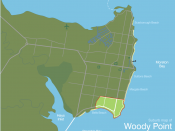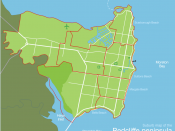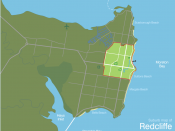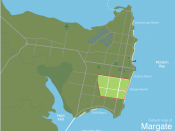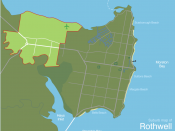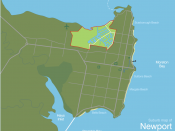The Ningy Ningy People of the Redcliffe Peninsula(Ninge Ninge, Ningi Ningi)The Ningy Ningy, whose name means 'oysters', are identified as being the southern most clan of the Undambi people of the Sunshine Coast. Ningy Ningy are red-ochre people and the traditional owners of my home town, the Redcliffe Peninsula, situated on the coast of South-East Queensland. The ancestral homelands of the Ningy Ningy people extend from the Pine River in the south to Elimbah Creek in the north; and from Old Gympie Road in the west to Pumicestone Passage in the east. The Ningy Ningy dialect is from the Kabi language group and is called Oondoo.
Fairhall, P. (1989), 'Ningi Ningi - Our First Inhabitants', Redcliffe Historical Society Inc., Queensland.
I was able to find this book easily in the Moreton Bay Regional Library but was dismayed to find that it was the only book available on the Redcliffe Peninsulas' first inhabitants.
Personally, I found Fairhall's book to offer a decent representation of the local history of the Ningi Ningi people as she endeavours to give readers an insight into the clan who lived in the area prior to Europeans landing in Moreton Bay and Redcliffe in 1824. I found the author referenced heavily the work of Steel (1984, p. 163) but the book also includes a lot of original research in regards to Redcliffe's local indigenous history.
One of the highlights of the publication for me personally are the remarkable interviews from older Redcliffe residents, most of whom have since passed themselves, in regards to prominent Aboriginal individuals throughout Redcliffe's history, the most famous being Boama (d.1913). I love the stories about Boama, whose name was changed to Sammy Bell after a local identity 'adopted' him. Sammy was adored by locals and supported himself by getting oysters and crabs for residents and visitors and could always be seen amusing visitors with his well-known songs and dances for pennies at the Woody Point Jetty. Sammy's story is significant to all residents of the Redcliffe Peninsula and features not only in Fairhall's book, but can also be seen in a touching visual display at the Redcliffe Museum and a memorial headstone at the Redcliffe Cemetery honouring the much-loved Sammy is still well visited to this day.
Despite the book's title, whilst an interesting introduction to the Ningy Ningy people of the Redcliffe Peninsula, I found the book to be lacking in any real discussion on the clans culture prior to European settlement. There is disappointingly little reference to shelter, food or clothing, spirituality or other anthropological history except for some mention of 'humpies', the traditional hut style of living prolific to the Redcliffe Peninsula beaches. The author seems more concerned with the Ningy Ningy's relationship with white man and all photographs within the publication feature Ningy Ningy people in European clothing, with no visual representation of traditional garments or decoration.
Whilst lacking in any cultural depth, there is conclusive evidence that the content of this publication is reliable and accurate and the information she presents is also consistent with other research I have undertaken on the Ningy Ningy people. I would personally describe this book, which is currently printed and distributed through the Redcliffe Historical Society, as an interesting and enjoyable collection of various documented and oral research that delivers a basic understanding of the history of the Ningy Ningy people and the area that they lived in, with much of the content designed to interest people who live in or visit the Redcliffe Peninsula region.
http://www.dakibudtcha.com.auThis website is the official website of the Ningy Ningy people, the traditional landowners and occupants of the Redcliffe Peninsula. The website also represents one of Australia's few indigenous record labels, Daki Budtcha Records, also owned and run by the Ningy Ningy people of Redcliffe. I found this website when I began to further explore and understand the pre-European life in my home town, the Redcliffe Peninsula.
The website immediately provides the user with an abundance of information on the Ningi Ningi people and you are easily able to identify with the areas local indigenous history by reading the sites narratives. Ningi Ningi culture, heritage and environmental issues are also discussed and a comprehensive map of the local area is also easily viewed.
The website is also home to Kurbingaibah which is the Ningy Ningy Centre for Indigenous Awareness that was opened officially in Redcliffe in 1997. Kurbingaibah is a Ningy Ningy word that means a place of the 'Kippa Rings' and the area of land has two ceremonial grounds including one of great cultural significance which is still in use today as a sacred area where young boys are initiated into manhood. The website details the centres rapid growth and outlines the list of activities provided by the Ningy Ningy community including cultural education, language classes, workshops, conferences and cultural awareness programs. I find Kurbingaibah to be a significant and exciting example of local indigenous cultural heritage preservation and from now on shall be a regular visitor.
There is also a vast array of colour and black and white photos on the website which allows the visitor to view some of our local Indigenous history, both past and present. Ningy Ningy artwork, local wildlife, musicians, songwriters and public ceremonies performed at the Kurbingaibah centre are also featured. Of particular interest is the visual evidence on the progress of the rigorous flora replanting of local provenance species undertaken since the land at Kurbingaibah was given back to the Ningy Ningy people.
In conclusion, this website values the cultural respect and safety of Indigenous Australians in particular the Ningy Ningy people. It is a vast, informative and interesting website where I was easily able to learn about the first inhabitants of the Redcliffe Peninsula and begin to identify with the Ningy Ningy clans history. The moderators welcome feedback from visitors to the website and provide a list of relevant links to others informative sites of interest regarding the Ningy Ningy clan. The website offers significant reference to the spirituality and culture of the Ningy Ningy people, much of this information I was unable to find elsewhere.
St Pierre, J. (1994), Moreton Bay Detachment 1824-25, The Redcliffe Historical Society Inc., Queensland.
A tattered copy of this seventy page publication was found by coincidence at a boot sale and traced to the Redcliffe Museum where a newly reproduced copy was purchased, disappointingly this book is not available at the Redcliffe Library.
The book mainly tells the story of how on 14th September 1824 the brig 'Amity' brought a party of officials, soldiers, their wives and children, and 29 convicts to land on the beach of the Redcliffe Peninsula to form a convict settlement 'due to the rapid expansion of the colony in present day Queensland' (Horton, 1994, p.72). St Pierre's book depicts the Ningy Ningy people's relationship with this first white settlement in Redcliffe and the non-indigenous author begins his tale by describing the initial reaction of the Ningy Ningy to the 'white-skinned people in their quaint attire' which arrived via a most unusual craft to land on their beach.
The book also tells the story of how just prior to the first settlement being built, three escaped convicts from Sydney, whose small boat was blown off-course into Moreton Bay by a violent storm, arrived on the shores of the Redcliffe Peninsula (Howitt 1996, map 81, p. 831). Exhausted and near starvation, they were rescued and befriended by the Ningy Ningy clan and were invited to reside with them. The group of men and their Indigenous friends would often travel south into Turrbal land, now known as Brisbane, and were presumably the first Europeans to ever see the Brisbane River. This is an interesting and factual story, and based on other information I have read during my research on this subject and the author offers a decent account of this part of our local history.
I thoroughly enjoyed the informative and sometimes humorous narratives as to how the Ningy Ningy people lived and interacted with other local indigenous clans and of course, the new settlers. There are some interesting descriptions of Redcliffe's pre-1900 landscape, its natural resources and the importance to the Ningy Ningy people.
The author continues to document the Ningy Ningy's involvement with the new settlement, their role in the construction of a penal colony and concludes by describing the eventual refusal of entry to 'black natives' into the new colony due to their 'cunning thievery' and swiftness in the removal of the colonies tools.
Some of these stories I found to be violent and condescending and St Pierre is often highly opinionated, with few or no references to back his claims. In fact, he is the only author I have found thus far to cite the Ningy Ningy as being an overly aggressive clan. I found the emphasis on these aspects upsetting and feel St Pierre's book is neither culturally aware nor is it sensitive. The constant reference to violence and other negative aspects in the books portrayal of the Ningy Ningy tribe diminishes its potential to be culturally safe (Atkinson et al., 2007, p.12) and would not be suitable for junior audiences.
Power, P.A., & Lorraine, B.T. (2008), 'Bardoo Mai and Other Indigenous Things', Self Published through Lulu.com.
I was fortunate to find a copy of this book available for purchase from the publisher's website (http://www.lulu.com/) after a patron of the Redcliffe Historical Society suggested the title to me.
Although the author was born in South Australia and raised in Alice Springs she has been a resident of the Redcliffe Peninsula for many years and is an Indigenous Australian woman who works closely with the Ningy Ningy people. I chose this body of work as Power is not only an Indigenous artist and author who lives and works on the Redcliffe Peninsula, but her book is often based on her experiences as an indigenous woman who lives here.
The author is also a member of the "stolen generation" of Indigenous Australians and interestingly her story tells of being the first Indigenous child to be formally fostered by an Indigenous woman. Her story describes her thirty six year search for her original family and the successful outcome which was only made possible because of an advocate from Link Up Queensland based here in Redcliffe.
The book sadly tells of Power's experience of being ill with pneumonia and alone with young children and no-one to help. She found that there was no support for Indigenous people from mainstream or community organisations on the Redcliffe Peninsula. This became the catalyst for a new Indigenous support group, which began in 2006 and is still running today. A large focus of the book is aimed at telling the story of this group, which is for Indigenous women in the Redcliffe Peninsula area to network and assist each other in times of need, including the failure of the first group due to 'non-Indigenous colonisers interference'.
Whilst this book may tell of the author's experiences with planting an idea to nurturing it to what it has become today, she is also blatantly honest in her description of the hardship she has suffered. Power is able to tell a story well and has managed to incorporate not only her own history, but that of her people, her children, her extended family and white Australians. The book, though often personally confronting, gave me a contemporary autobiographical account of her varied experiences in the candid, but often heart wrenching story, of her life so far.
The book is not only autobiographical and historical but also brilliantly educational with Powers including several traditional Indigenous recipes in the book for cooking such fare as green ants and making green ant cordial, witchetty grubs and finishes with a fabulous lesson on how to cook turtle. An interesting added bonus to the book is the author's inclusion of an Indigenous Australian Dictionary and the book concludes with a chapter on Indigenous Languages of Australia.
This book was self-published after Power applied for and received a Regional Arts Development Fund grant from the Redcliffe City Council which I feel gives this author even further credit. Her story is co-written with Brody T. Lorraine remarkably well with both cultural sensitivity and responsibility and I would highly recommend this book to all readers.
Reference ListAtkinson, J., Blomeley, B., Lewis, L., Lynwood, R., Townsend-Cross, M., & Woods, G. (2007) 'CUL00401- Indigenous World Views: Study Guide', 2nd ed., Southern Cross University, Lismore.
Ford, R. & Blake, T. (1998) 'Indigenous Peoples of Southeast Queensland: A guide to ethno-historical sources', FAIRA Aboriginal Corporation, QLD.
Horton, D (ed.) (1994) 'Encyclopaedia of Aboriginal Australia', Aboriginal Studies Press, Canberra.
Howitt, A.W. (1996) 'The Native Tribes of South East Australia', Aboriginal Studies Press, Canberra.
http://www.lulu.com/Steele, J.G. (1984), 'Aboriginal Pathways in South East Queensland and the Richmond River', University of Queensland Press.
